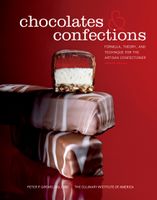By Peter Greweling and Culinary Institute of America
Published 2007
Maple syrup and maple sugar are both made by concentrating the sap from the sugar maple, or black maple, tree. Sap from maple trees typically contains approximately 2 percent sugar, nearly all of which is sucrose. To concentrate the sugar, the sap is boiled in open evaporators in order to remove the desired quantity of water. Maple syrup is boiled to a dissolved-solids content of just over 66 percent. At this concentration the syrup is saturated but will not crystallize easily. Maple sugar is made by removing more water and inducing crystallization of the sugars. In addition to removing water, boiling causes Maillard browning and some inversion. Maillard browning, in particular, is crucial to the development of maple syrup’s and maple sugar’s characteristic flavor, so the time and temperature must be carefully controlled for optimal results. (See Maillard Reaction.) The flavor of maple syrup and sugar is also influenced by environmental factors such as climate, soil type, and the point in the season when the sap is harvested. The highest grade of maple syrup is the lightest in color and flavor; the lowest grade is the darkest, which has a less subtle, more robust flavor and may therefore be better suited to confectionery applications.
Become a Premium Member to access this page
Unlimited, ad-free access to hundreds of the world’s best cookbooks
Over 160,000 recipes with thousands more added every month
Recommended by leading chefs and food writers
Powerful search filters to match your tastes
Create collections and add reviews or private notes to any recipe
Swipe to browse each cookbook from cover-to-cover
Manage your subscription via the My Membership page
Part of
Advertisement
Related Recipes
-
-
-
-
Related Reference
-
-
-
-
Advertisement




